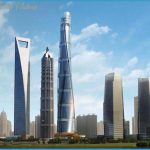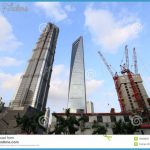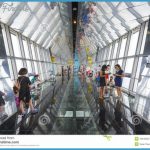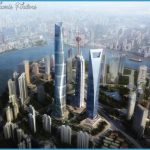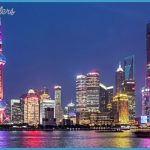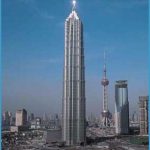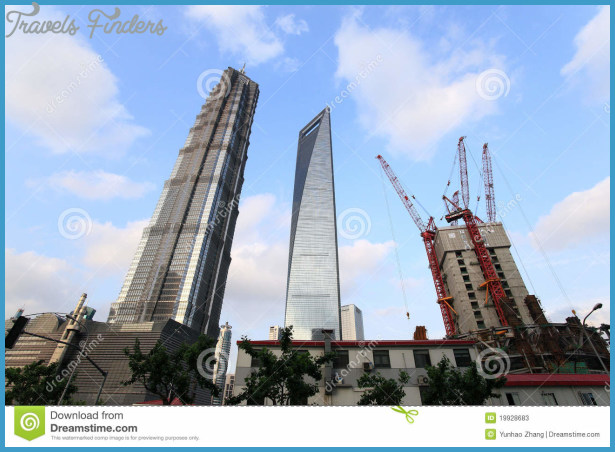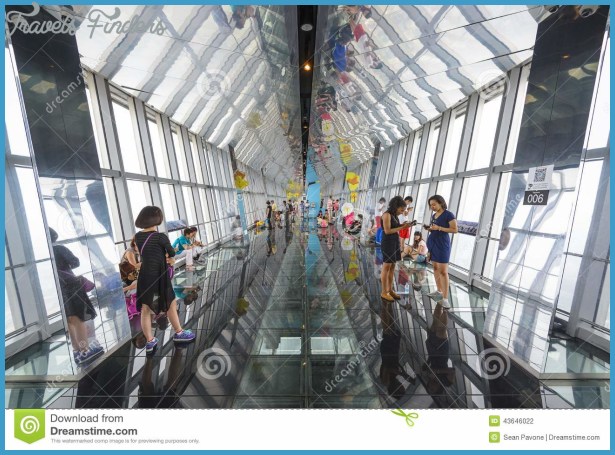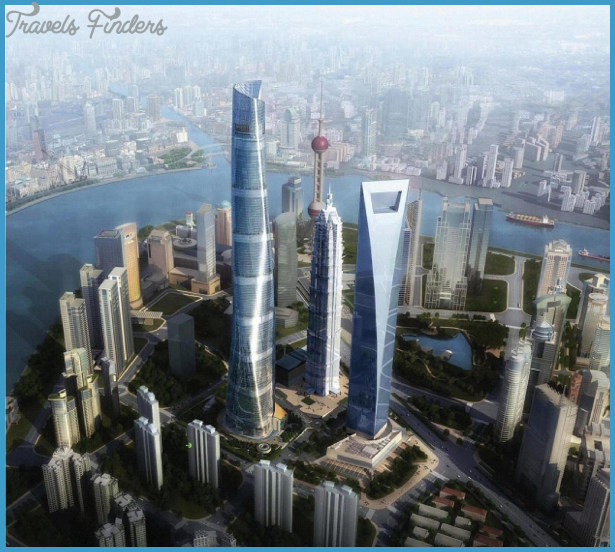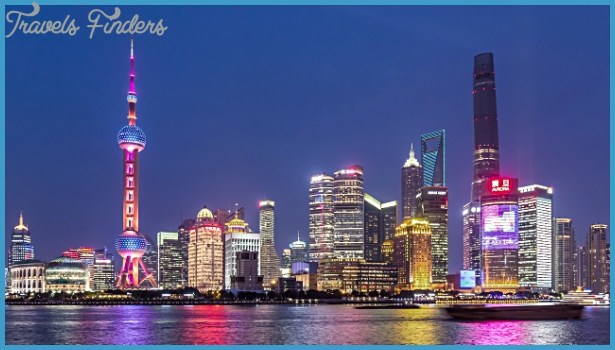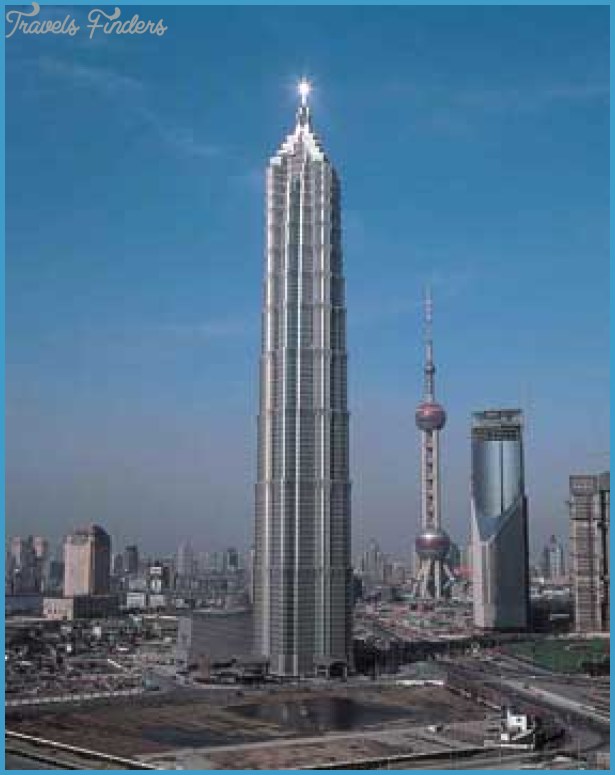ADRIAN SMITH
Since the 1990s no city has seen such dramatic growth as Shanghai.
As China developed economically, Shanghai acquired a vast number of new buildings, from shops and banks to office blocks and hotels. The city spread onto land once occupied by farms, but the expansion was vertical as well as horizontal. Among the crop of recent skyscrapers one of the tallest and most spectacular is the 1,380ft (4,205m) Jin Mao Tower.
The tower was designed by a large team under the leadership of Adrian Smith of the firm Skidmore, Owings and Merrill (SOM), an American practice responsible for many of the world’s largest and tallest office buildings. In keeping with these origins, the Jin Mao Tower is a high-tech structure of steel, concrete, and glass, but it also has many traditional features. These start with its name, which means “Golden Luxuriance Building, and also relate to its proportions. Many of the tower’s measurements and statistics involve the number eight, a number that has traditionally been considered auspicious in Chinese culture. The tower has 88 stories divided into 16 segments, and its height-to-width ratio is 8:1. At the tower’s heart is an octagonal concrete core, and the building has two sets of eight structural columns. The dedication ceremony took place on 28 August 1998, but the tower was not fully completed until 1999.
The building is a mixed-use development with many different occupants. The adjoining Podium building contains conference and banqueting facilities and a shopping mall. The main tower has some 50 floors of offices, and floors 53 to 87 are home to the five-star Shanghai Grand Hyatt Hotel, which has 555 rooms and is one of the tallest hotels in the world. Above the hotel on floor 88 is a large, enclosed observation deck, accessed by express elevators, that offers breathtaking views of the expanding city of Shanghai.
ADRIAN SMITH
The American architect Adrian Smith joined SOM in 1967, when the practice was at the forefront of skyscraper design. Founded in 1936, it designed many of the world’s best-known steel-and-glass towers, including Chicago’s John Hancock Center (1969) and the Sears Tower (1973). During his time with SOM, Smith designed many award-winning office developments in the US, Britain, and China. He worked on high-profile commercial buildings, such as the Trump International Hotel and Tower in Chicago and London’s Canary Wharf and Bishopsgate developments. One of his best-known projects is the Burj Khalifa in Dubai, a super-tall skyscraper with a unique tapering design. When it opened in 2010, it was the tallest building in the world. In 2006 Smith left SOM to set up a new practice, Adrian Smith + Gordon Gill Architecture, where he continues to design prestigious, tall buildings.
Visual tour: exterior
4 VIEW FROM STREET LEVEL This view of the Jin Mao Tower shows how the face of the building works as a series of expanses of metal and glass, stepping back at the edges and anchored with a central vertical spine that juts out slightly.
The surface is broken at intervals by darker horizontal bands. Each band is set at a slight angle to give the building a profile similar to an understated version of a traditional Chinese pagoda. This is one example of the way in which the architects blended traditional and modern elements in their design.
2 JAGGED CROWN The design of the tower becomes more complex as it rises, drawing the eye upward as it undergoes a series of dramatic changes in shape at the top. Here, there are four stories with outward-splaying walls, each slightly smaller than the one below. Above these is the observation deck, and higher still is the crown, a collection of jagged fins terminating in a tapering finial. Gray during the day, the crown of the building is illuminated at night to form a bright, glowing landmark.
IN CONTEXT
During the decades after World War II developers built taller and taller skyscrapers. Most of these were variations on the glass-and-steel box, usually a flat-sided, rectangular structure supported by a metal framework. In the last 20 years, however, skyscraper designs have evolved, their different forms designed with the aid of computers and constructed using the latest materials. Gently curving walls and towers that twist as they rise are now possible; so are skyscrapers based on tubes or shards, or buildings that swell and taper. International firms, such as SOM, Foster and Partners (architects of London’s Gherkin building), and Kohn Pedersen Fox (the Shanghai World Financial Center), are at the forefront of such innovative designs.
1 ENTRANCE At ground level a series of doors leads into the tower. These openings are surprisingly plain and understated for the entrance to such a prestigious building, but the near-circular window above offers a glimpse into the lobby, increasing the visitor’s sense of anticipation and excitement.
1 Burj Khalifa, Dubai 1 Shanghai World This skyscraper by SOM Financial Center is 2,723ft (830m) tall. This is 1,599ft (487m) high.
1 PIPING The metal elements of the building are made of aluminium alloy and various types of steel, including stainless steel. These pipes of stainless steel are part of the structure that supports the glass-roofed arcade at the foot of the tower, through which is the access to the many offices.
1 CLADDING A close-up of part of the exterior shows how the walls are constructed as a series of setbacks (steplike recessions). These have various advantages: they break up and add interest to the fagade, enabling
the shape of the building to change as it rises.
The windows also face in different directions, which means that more natural light can enter the building as the sun moves around it during the day.
Visual tour: interior
4 ATRIUM FROM BELOW The upper part of the building, from floors 53 to 87, is occupied by the Grand Hyatt Hotel. At the heart of these floors is a cavernous atrium, encircled by a series of corridors. This remarkable space, one of the world’s tallest atria, is around 377ft (115m) high and 88ft (27m) across. The stairs from one level to the next are arranged in a spiral, made visible by slight protrusions on the corridors.
3 ATRIUM FROM ABOVE From the observation deck, the view downward shows the difference in treatment between the corridors and the convex wall of the atrium. While the corridors are treated as a series of light and dark rings, the convex wall is much smoother and is articulated with a grid of rectangles. The impression of rich, golden surfaces bathed in light from the corridors recalls the golden luxuriance of the tower’s name.
4 ELEVATOR LOBBY The sense of opulence, so obvious in the atrium, is also evident in the elevator lobby, where the light and dark materials of the floors and ceilings combine to create a striking pattern.
The elevators themselves are decorated in gold, which adds to the luxurious quality of the interior.
2 SPIRAL STAIRS The Podium building has stairs as well as escalators. In many similar buildings the stairs are hidden away in corners or behind doors, but in the Podium they are a decorative feature in their own right. The parallel steel rails and treads make an elegant spiral around two structural columns.
4 FRAMEWORK STRUCTURE Although the low Podium is in many respects a very different kind of structure from the super-tall skyscraper beside it, the two buildings share a common feature the use of structural columns and tubes that are exposed to view. This steelwork plays a major part in the visual impact of both buildings.
2 INSIDE THE PODIUM
This six-story building is to one side of the main tower.
It offers conference and banqueting facilities for the Shanghai Grand Hyatt Hotel, together with a concert hall, shops, and restaurants. The Podium has a large, top-lit atrium framed with steel and contains a stack of escalators at one end. Suspended glass floors are a feature of this part of the structure, allowing light to pass between levels.
3 OBSERVATION DECK
This viewpoint is near the top of the tower, immediately below the crown, and can be reached quickly using two express elevators. Although the observation deck looks small from the ground, it has enough space for more than 1,000 people, who can gaze out of the tall glass windows across the city and beyond.

